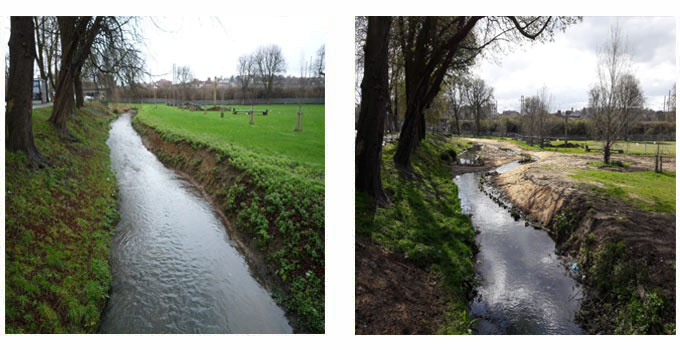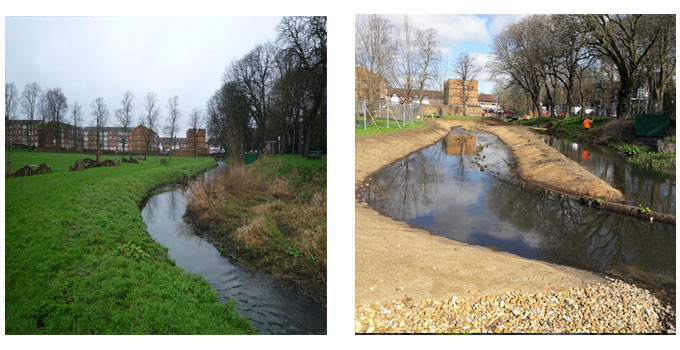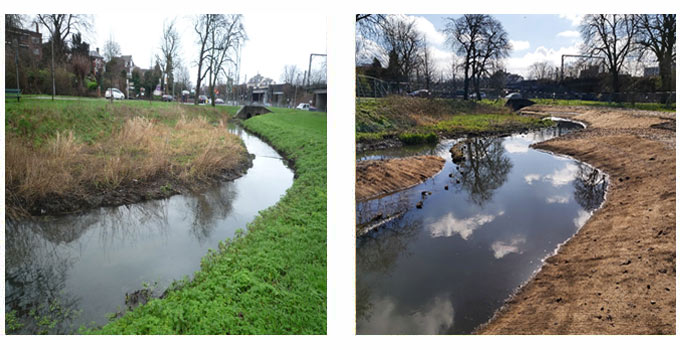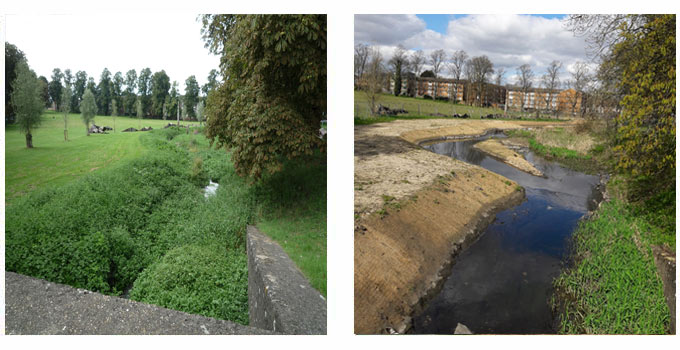New Bedford Road, Luton
The Moor river improvement project is one of a number of projects that are taking place as part of the Revitalising Chalk Rivers partnership, in collaboration with the Environment Agency.
We have worked in partnership with Luton Borough Council and the Luton Lea River Catchment Partnership. These improvement works will help to restore and improve the habitat of chalk streams along the River Lea and to meet the EU Water Frame Directive of Good Ecological Potential by 2027.
What was the problem
The channel is generally over-wide, especially at the upstream end, and consequently, sediment is deposited on the bed, smothering any gravel that may be present (Figure 1).
This is a problem, as gravel is vital for the spawning of many fish species, such as trout, and also supports a wide range of invertebrates. The steep right bank requires re-profiling to allow plants to become established and to reduce the amount of silt entering the river. (Figure 2), the trees on the left (east) bank overshade the river, restricting the growth of in-channel and marginal plants.

Looking downstream, a view of the River Lea at The Moor, from the north before (figure 1 - left) and after (figure 2 - right) the restoration.
What did we have to do?
- To naturalise the River Lea in Luton as much as possible.
- To improve biodiversity in the river corridor.
- To help the river meet the requirements of the Water Framework Directive.
- To make the river more resilient to low-flows.
- To carry out tree works and cut back overgrown trees, to allow sunlight to reach the river and its banks.
- To reprofile the river banks and re-meander the river channel further into the park (Figures 3 and 4).
- To create wetland areas and a backwater; (Figures 5, 6, 7 and 8).
- To improve the river as an amenity feature for the local community.
- To reduce the risk of flooding.
Construction started on 6 January 2020, our contractor battled the storms of Ciara and Dennis and the subsequent high river levels to complete the project on time by the end of March 2020.
We constructed a bund to divert the river down the new channel that meanders further into the park. The old river channel now provides a wetland habitat and a buffer from road run-off pollution.
Berms, riffles and pools have been created in the new river channel to provide a mosaic of different habitats for insects, plants and fish.
The river channel has also been designed to be resilient in times of low-flow and has increased the flood capacity of the wetland areas by 700m3.
The after photos look a bit raw at the moment but given time come the summer the vegetation will be growing through the coir matting.
Take a look at how the project has evolved
See the improvements

Looking upstream from the middle of the site, before (figure 3 - left) and after (figure 4 - right).

Looking downstream to the lower end of the site, before (figure 5 - left) and after (figure 6 -right).

The downstream end of the reach, before (figure 7 - left) and after (figure 8 - right) the restoration (March 2020).